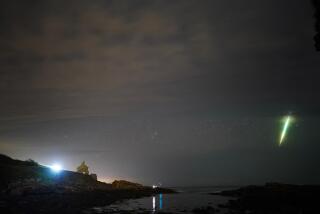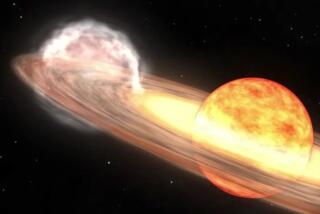Tonight! Geminid meteor show, moving at 80 stars per hour
Got plans Thursday night? Cancel them. You have some sky-watching to do.
The Geminid meteor shower is expected to peak late Thursday evening into Friday morning, and you donât want to miss it. Scientists say it is going to be the best meteor shower of the year with as many as 80 meteors per hour or maybe more.
And if youâre lucky, a second, surprise meteor shower will serve as an opening act for the Geminids. Scientists say we may pass through decades-old debris left behind from the comet Wirtanen, which would add an additional 10 to 30 comets per hour.
The Geminid meteor shower is an annual light show that happens in mid-December. The shooting star display occurs as the Earth passes through rocky pieces of debris left in the wake of an extinct comet called 3200 Patheon.
3200 Patheon is now a ârocky skeletonâ of a comet, since it lost all of its ice after too many close brushes with the sun. (Thereâs something romantic sounding about that). Its orbit takes it closer to the sun than Mercury and goes closer to the sun than any other named asteroid.
The best time to view the shower (or showers) is in the dark hours between local midnight and sunrise, according to SpaceWeather.com. The meteors seem to be emanating from the Gemini constellation; hence the name âGeminids.â
If meteors from the debris of comet Wirtanen are visible, youâll find them radiating from the center of the constellation Pisces.
If, like me, you live in an area plagued by light pollution, youâve got a few options. If you are ambitious, pack up the car and get yourself to the darkest area you can find (here in L.A. that might be the top of Mt. Wilson or somewhere in the desert).
If that is not a reality for you, then consider watching the show on your computer. NASA will be live streaming the meteor shower from a camera at its Marshall Space Flight Center in Huntsville, Ala., where a NASA spokesperson promises it is very dark.
The live stream begins at dusk, and NASA scientists will be available to answer questions from 8 p.m. to 12 a.m. PST.
No one is going to pretend that watching a meteor shower on your computer can quite live up to the excitement of laying on your back in the park, but youâll still get to share in the event. And, of course, ask NASA scientists anything you want!
For a taste of what you might see, hereâs video that NASA took of the meteor shower on Dec. 12.
ALSO:
The year of the Apple: From Foxconn uprising to a Mini roll-out
Google zeitgeist: We google for Big Brother, for Canada, for love
Behold the Black Marble: Breathaking images of the earth at night
More to Read
Inside the business of entertainment
The Wide Shot brings you news, analysis and insights on everything from streaming wars to production â and what it all means for the future.
You may occasionally receive promotional content from the Los Angeles Times.











